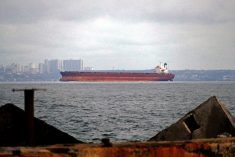MarketsFarm — Ocean freight rates have shown some strength in late February, with the Baltic Dry Index (BDI) recovering off two-and-a-half-year lows hit earlier in the month.
The BDI, a major indicator of bulk shipping rates, has risen for seven straight sessions to settle Monday at 935 points, up from the low of 530 points hit on Feb. 16. The BDI had traded above 3,000 points as recently as May 2022. Increased shipments of iron ore out of Brazil and Australia reportedly contributed to the increase in the BDI.
The BDI is compiled by the London-based Baltic Exchange and provides an assessment of the price of moving major raw materials by sea. The overall BDI includes sub-sectors for the different classes of ocean vessels such as capesize, panamax and supramax. It is often seen as a leading indicator of global economic activity.
Read Also

U.S. livestock: Feeder cattle hit contract highs on tight supply
Chicago | Reuters – All Chicago Mercantile Exchange feeder cattle futures and most live cattle futures hit contract highs on…
While bulk rates have shown some improvement, container rates remained in a steady downtrend. As of Feb. 23, Drewry’s World Container Index (WCI), which tracks container rates, was at US$1,898 per 40-foot container. That marked an 82 per cent drop from the peak hit in September 2021 and is 30 per cent below the 10-year average. However, the Drewry WCI is still up from the pre-pandemic rates averaging US$1,420 in 2019.
Canada is at a freight disadvantage compared to its competitors exporting grains and oilseeds into many markets, with lower freight rates helping counter that disadvantage.
— Phil Franz-Warkentin reports for MarketsFarm from Winnipeg.

















